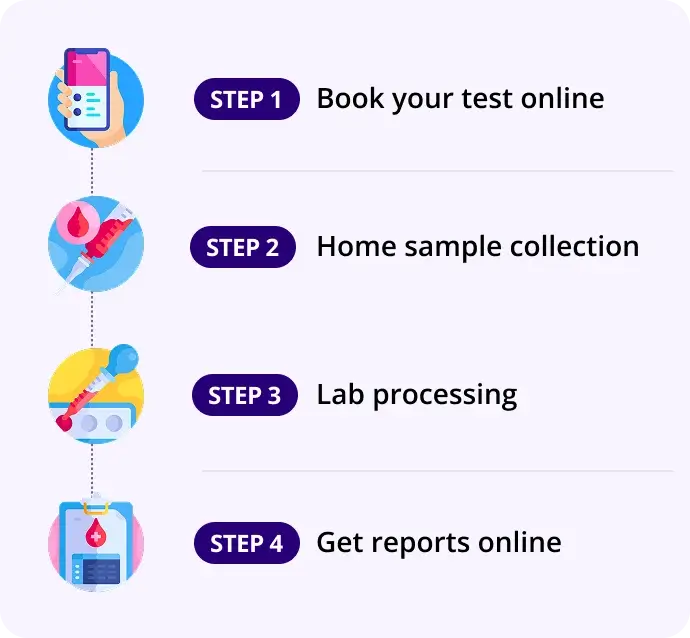Apolipoprotein - B
Report in 16Hrs
At Home
Fasting Required
Details
Apolipoprotein B (Apo B) is the primary protein found in atherogenic lipoproteins, including: Low-Density Lipoprotein (LDL), Very Low-Density Lipoprotein (VLDL), Intermediate-Density Lipoprotein (IDL), Lipoprotein(a)
₹269₹495
46% OFF
Apolipoprotein B (Apo B) Test
| Parameter | Details |
|---|---|
| Sample Type | Blood (Serum) |
| Fasting Required | ✅Recommended (8–12 hours for most accurate lipid analysis) |
| Method | Immunoturbidimetry / Nephelometry |
| Turnaround Time | 1–2 working days |
What Is Apo B?
Apolipoprotein B (Apo B) is the primary protein found in atherogenic lipoproteins, including:
Low-Density Lipoprotein (LDL)
Very Low-Density Lipoprotein (VLDL)
Intermediate-Density Lipoprotein (IDL)
Lipoprotein(a)
Each atherogenic lipoprotein particle has one Apo B molecule, so the Apo B level reflects the total number of atherogenic particles in the blood.
Apo B gives a more precise risk estimate of heart disease than LDL cholesterol alone.
Organs/System Involved
| Organ/System | Function |
|---|---|
| Liver | Synthesizes Apo B-containing lipoproteins |
| Cardiovascular | Apo B-rich particles contribute to plaque formation (atherosclerosis) |
Why Is This Test Done?
| Purpose | Use Case |
|---|---|
| Assess cardiovascular risk | Better predictor than LDL in many individuals |
| Diagnose atherogenic dyslipidemia | Especially in metabolic syndrome or type 2 diabetes |
| Monitor lipid-lowering therapy | Track response to statins or lifestyle modifications |
| Clarify LDL discrepancies | When LDL-C is normal but risk seems elevated |
Interpretation of Results
| Apo B Levels | Cardiovascular Risk Interpretation |
|---|---|
| < 90 mg/dL | Optimal (low risk) |
| 90–120 mg/dL | Borderline risk |
| > 120 mg/dL | High risk |
| > 130 mg/dL (esp. in diabetes) | Significantly elevated risk |
Lower Apo B = fewer atherogenic particles = lower risk of heart attack/stroke.
Associated Conditions
| Condition | Relevance to Apo B |
|---|---|
| Coronary artery disease (CAD) | Apo B promotes plaque formation |
| Type 2 diabetes | Increased small dense LDL (high Apo B) |
| Familial hypercholesterolemia | Very high Apo B levels common |
| Metabolic syndrome | Apo B often elevated even if LDL is normal |
| Obesity | Apo B elevated due to poor lipid metabolism |
Recommended Additional Tests
| Test | Purpose |
|---|---|
| Apolipoprotein A1 (Apo A1) | Used to calculate the Apo B : Apo A1 Ratio – a powerful CVD predictor |
| Lipid Profile | Total cholesterol, LDL, HDL, Triglycerides |
| Lipoprotein(a) | Inherited risk factor for CVD |
| hs-CRP | Assesses vascular inflammation |
| Homocysteine | Linked to endothelial dysfunction |
| HbA1c / FBS | Evaluate for diabetes/metabolic syndrome |
Who Should Get the Apo B Test?
Individuals with:
o Family history of heart disease
o Elevated LDL or triglycerides
o Diabetes, prediabetes, or metabolic syndrome
o Low HDL but normal LDL
o Normal cholesterol but high cardiovascular risk suspicion
People on statin therapy (to monitor residual risk)
Summary Table
| Test | Apolipoprotein B (Apo B) |
|---|---|
| Measures | Number of atherogenic lipoprotein particles |
| Organ/System | Liver, cardiovascular |
| Fasting Required | ✅ Recommended |
| Risk Indicator | High Apo B = increased risk of heart disease |
| Common Add-On Tests | Apo A1, Apo B:A1 Ratio, Lipid Profile, hs-CRP, Lp(a) |
| Best Used For | Cardiovascular risk evaluation, statin response monitoring |
How our test process works!

